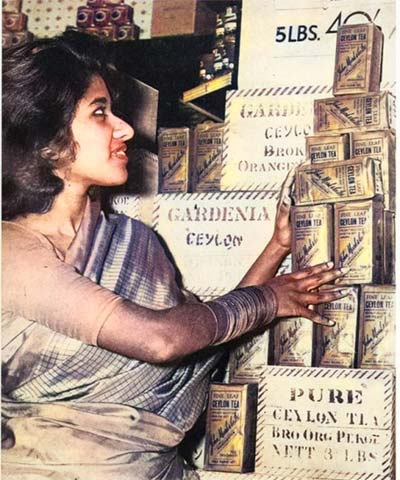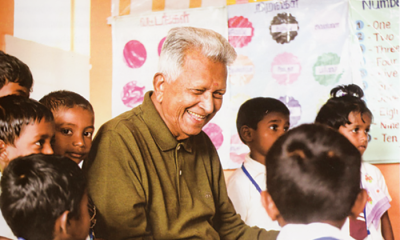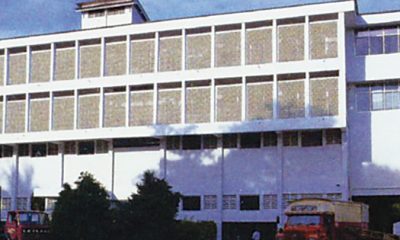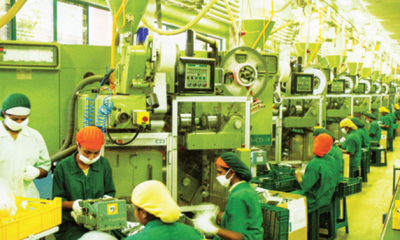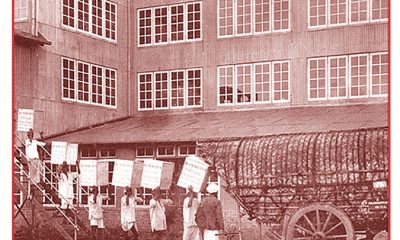Features
The struggles within, friends and opponents, the Tea Board, the Tea Propaganda Board and CTTA

Excerpted from the autobiography of Merrill J. Fernando
If the chokehold that British interests exerted on the local entrepreneur was not strong enough to stifle him, the additional pressure needed to hobble him further was created by the machinations of the vested interests within, both wittingly and unwittingly aided by a shortsighted bureaucracy and trade associations with self-serving agendas. My relationships with all these organizations have been contentious and confrontational. Over the years I have been unapologetically critical of many of their policies and strategies, which I considered to not be in the best interests of the local brand builder and exporter.
The Ceylon Tea Traders’ Association (CTTA) came into being in 1894, in the early formative stages of the tea export trade, to mediate on behalf of growers and exporters and to solve their problems. It was a creation of the British and given the nature of colonial dominance of the country then, it was but natural that protection of British interests within the industry would be its first priority.
The Ceylonese ‘native’ tea traders who were in the minority till the late 1960s, permitted this state of submissiveness to colonial domination to prevail for decades after Independence. Whilst the CTTA committee comprised equally of sellers and exporters, five representatives of each, it was still dominated by Europeans.
The general insensitivity of the CTTA to needs of locals was exemplified by an incident in 1968, when the committee refused to suspend the tea auctions for an hour or so, to enable Muslim members to visit the mosque, on an occasion when an important Muslim religious festival coincided with an auction day. I discussed this matter with the late Abbas Akberally, then Chairman of Akbar Brothers and tea exporter Amin Suby, who were both of the firm view that a change in the CTTA representative body was an urgent need. The resentment caused by this episode eventually crystallized in a changing of the guard in the CTTA, with the ‘native’ segment taking control of its affairs for the first time in its history.
For the first time the post of Chairman was contested, and Austin Perera from the Cooperative Tea Society was voted in. The next and even bigger shock was when all Europeans in the buyer segment, with the exception of George Willis, then Chairman of Lipton, were ousted and replaced by five local shippers: Co-operative Tea Society Ltd., M.S. Heptulabhoy & Co. Ltd., Merrill J. Fernando Co., Suby Tea, and Van Rees Ceylon NV. It was a ‘palace coup,’ which the ruling parties were ignorant of until they were deposed.
Despite the first successful Ceylonese incursion into what had always been a closely-guarded preserve of British interests, there were subsequent attempts by interested parties to dilute the local influence. In 1969, an unusually large number of plantation companies in the Whittall Estate Agency, applied for membership of the CTTA. I opposed this strongly on the grounds that plantation interests were already adequately served by the Planters’ Association and that it would be inequitable to permit the sellers to outnumber the buyers in the membership of the CTTA. The subsequent vote endorsed my view, with the support of George Willis, who was one of the few servants of British interests to objectively view the aspirations of local exporters.
An objective insider speaks
The relevant extract (reproduced below) from the book ‘George Steuart & Co. Ltd., 1952-1973, A Personal Odyssey,’ by Tony Peries, former Chairman of George Steuart, provides an illuminating insider’s view of this historically significant episode. In a few well-worded paragraphs, he also outlines the impediments and obstacles which then existed to the advancement of the local exporter, and to the cause of Pure Ceylon Tea, globally.
[QUOTE:] The Colombo Tea Traders Association (CTTA) made the rules under which tea auctions were held and to buy at the auction a firm had to be a member. More or less the same firms comprised the five buyers/ five sellers committee year after year, and Forbes and Walker was always the advisory broker who had no vote. The buyers, from memory, were Brooke Bond Ceylon Ltd., Lipton Ltd., Harrison & Crossfield Ltd., Heath & Co (Ceylon) Ltd., and M.S. Heptulabhoy & Co. Ltd. The sellers were Carson Cumberbatch & Co., George Steuart & Co. Ltd., Gordon Frazer & Co. Ltd., Colombo Commercial Company and Whittall Boustead Ltd. .
As many as 411 the sellers save George Steuart and Frazer were also buyers of some significance, but I never saw or even had reason to suspect firms with dual interests doing anything adverse to affect their selling side and if anything, they occasionally gave their own teas a bit of help. However, criticism of firms ‘on both sides of the fence’ was rife.
By 1967, the small Ceylonese firms, most of them dwarfed by Brooke Bond, Lipton type giants, far outnumbered the long-established British outfits on the CTTA membership list. The owner of one such firm was Merrill J. Fernando, who had started life at A. F. Jones & Co. Ltd., become a Director there, and subsequently opened up his own firm under his name. Among those smaller firms, the majority was owned by the Muslim community. Heptulabhoys was the most significant, but Jafferjees and T Suby were also well known and respected.
The local traders, identified by the expatriate community as ‘natives,’ -felt that their needs were ignored by the CTTA (the old diehards like George Savage actually wrote N’ for native in their catalogues as they could not bother with long local names like Heptulabhoy!) A typical example was the committee’s refusal to suspend the tea auctions for an hour or so, on one occasion, on, to enable Muslim members to visit the mosque on a particular festival which fell on a tea auction day, having initially refused to reschedule the auction date. That same year the small exporters worked together to throw out the previous committee, leaving only George Steuart from the old brigade.
It fell to Merrill to give leadership to the newly-elected committee. He was intelligent, articulate, and forceful. His main objective was to get on the committee of the Ceylon Tea Propaganda Board (CPBT), where the CTTA had ex-officio sellers and buyers nominated by the committee. I had only a nodding acquaintance with Merrill and when the nomination paper came to me, I refused to endorse his nomination, which caused an awful stink.
My concern was that he lacked the knowledge to be on the CTTB. After some days of impasse, Arjuna Dias, a Tea Director at Somerville & Co. Brokers) and a close friend of Merrill, approached me with the suggestion that Merrill and I have a private meeting ng at which he would state his case.
I agreed and he very magnanimously came to 91 Steuart Place one evening, with Arjuna. Merrill’s argument was that the CTPB generated enormous amounts of money to spend on propaganda, as every pound of tea exported attracted a cess for propaganda (and research too) but that the control of that money was far too loose.
He certainly had a point, as in those days most of the propaganda money was, at the tea traders’ insistence, spent on generic propaganda, that is, tea advertised as tea and apart from the Lion symbol, which the packers were allowed to use on their packs, provided the blend comprised 50% Ceylon Tea, along with the legend `Pure Ceylon Tea, there was little done to promote Ceylon Tea specifically.
The pack contents of Ceylon Tea had to be unpoliced and the bona fides of the packers depended on a gentlemen’s agreement. Whilst I have no reason to believe there was large-scale cheating, the situation was really not very satisfactory as the major packers were in the excellent position of benefiting from tea (not Ceylon) advertising, at no cost to themselves. The CTPB ran ‘Ceylon Tea Centres’ in London and various other major cities but their impact was minimal and the London Centre, for instance, though it a fine location in the Haymarket, was best known as a good lunchtime curry house.
Merrill was by then selling some tea in Italy and other parts of Europe, but I remember Italy particularly as the CTPB representative there was a man named Egidio, who Merrill maintained was totally unhelpful to members of the trade. Merrill ‘s point was that the money spent on generic promotion and on promoting foreign-owned brands should now be expended towards helping the development of Ceylonese-owned brands.
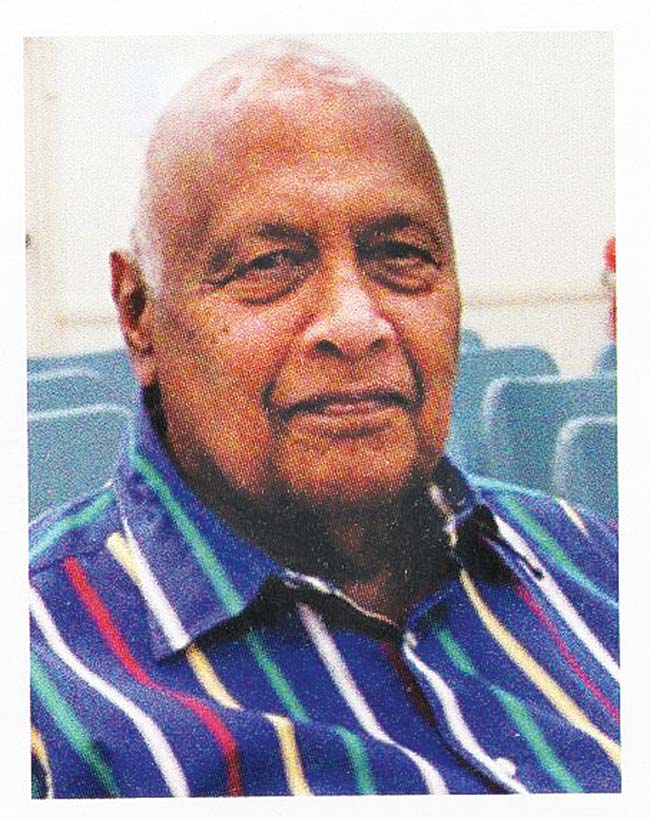
Tony Peries — Then Chairman of George Steuart & Co, assisted me with the Ceylon Tea Propaganda Board
When we met at Steuart Place we did not discuss all this detail, but I agreed to support Merrill’s nomination. We parted friends and have remained so ever since. Merrill is the one man who has over the years established his ‘Dilmah’ brand very successfully just about everywhere in the world. I am aware of how very difficult it is to get a new brand in to the Australian supermarkets, where Dilmah’ is now widely stocked, so he has taken a hard road and persevered in putting truly pure Ceylon Tea, packed in Ceylon, on the map. I am only sorry I ever opposed him. [END OF QUOTE]
I was very pleased that Tony considered the issues sufficiently important, for them to be given prominence in his memoir, written more than 30 years after the episode. After moving to Australia in 1973, Tony carved out a very successful career for himself in the private commercial sector in that
country. About eight years ago, when I was visiting Australia, he got in touch with me with a request to address a meeting of the Sri Lanka-Sydney Business Society, of which he was the Chairman. He had always been highly appreciative of the success of Dilmah and was very keen on my explaining to the gathering, my vision for Ceylon Tea and the success of Dilmah.
I accepted with pleasure as that would have also given me the opportunity of meeting up with many of my Sri Lankan friends in Australia. However, having accepted the invitation, I realized, to my utter dismay, that the SLSBS event would coincide with a public relations event featuring 26 important journalists in New South Wales, in which I was due to appear. Eventually I compromised by making a short address at the SLSBS event and answering a few questions, before making an early departure.
Promotion of pure Ceylon tea, obstacles and pitfalls
The incisive observations of Tony Peries an objective and knowledgeable insider of the plantation industry reproduced in the previous chapter, clearly demonstrate the self-serving nature of the very organs established to assist the trade and the exporter.
The Ceylon Tea Propaganda Board (CTPB) became active in the early 1930s and was incorporated with the present Ceylon Tea Board, when the latter was established in 1976. The Chairman of the Tea Board was invariably a political appointee but the organization functioned under a full-time Director General. The first Chairman of the Tea Board was Ajith Goonatilleke, who had earlier been a Senior Estates Management Executive at the George Steuart agency.
There were also periods when the Chairman of the Tea Board and the Secretary of the Ministry of Plantations was one and the same individual, for instance the career civil servant Bradman Weerakoon. I believe that at the outset, Goonatilleke’s appointment as Chairman of the Tea Board and his substantive position as Secretary to the Ministry of Plantations, under then Minister Ratnasiri Senanayake, may have briefly overlapped.
Before the emergence of Ceylonese exporters as a force in the trade, most of the private trade representatives were from multinational companies, including Lipton and Brooke Bond. Therefore, understandably, British interests received priority support whilst there was no voice to promote Sri Lankan interests. I served two terms as a member of the CTPB, in the 1960s and ’70s, but several proposals I submitted regarding the establishing of Sri Lanka brands attracted little or no support, from the Board and the Secretariat.
I was deeply pleased by my appointment to the Ceylon Tea Propaganda Board, as it provided me a great opportunity to present to an important body, the views of a practicing tea trader. The Chairman was M.A. Bartlett, then a Director of Carson Cumberbatch, and the Secretary was Clarence Cooray, who had been with the CTPB for quite some time. The other members of the Board were chairmen of agency houses, brokers, and representatives of the smallholders.
At the very first meeting, when I spoke of the need for the promotion of value-added export of locally-owned brands, whilst Bartlett was very supportive, Maynard, Chairman of Brooke Bond, strongly vetoed the idea. His argument was that value addition at source would require blending from multiple regions and that it would not be practical.
Consequent to Bartlett’s term and Cooray’s retirement, Bertie Warusawitharana, a well-known planter from the south, was appointed Chairman, whilst Elmer Martenstyn, who had been Executive Director of the CTPB in the early 1970s, was appointed Director General and Victor Perera, Secretary. The then situation in that Board was such that Perera had filed an injunction against Martenstyn, and the two were not on speaking terms. Martenstyn was resentful of my inquiries regarding this issue but I was supported by two other Board members, Park Nadesan and Buddhi De Zoysa, the Treasury representative. Another member of the Board who supported new initiatives and new thinking was the late Stanley Jayawardena, then Chairman of Unilever.
The CTPB had within its ambit, both an overseas and a local marketing committee. The Commissioner of Domestic Marketing was one Arasanayagam. Inquiries that de Zoysa and I made revealed that although funds had been allocated for a tea promotion campaign in the east and the north, the tea had simply been handed over to some State institutions for distribution. Eventually, the Minister ordered the CTPB to immediately stop the “futile” campaign to promote tea locally (Ceylon Observer, 4 April 1969).
At the end of my first term, I found out that Martenstyn had privately requested Conrad Dias, then Secretary of the Chamber of Commerce, to nominate a less-confrontational individual. Much to Martenstyn’s displeasure, I was nominated by the Chamber for the second successive term.
The CTPB came in for severe criticism by the Minister of Plantations, Colvin R. de Silva, for its “disregard for promotional” work, its inappropriate appointments to the overseas Tea Centres, such as that of an Egyptian with no previous experience on tea to its Cairo office, and the employment of Kenyan girls at the London Tea Centre, despite the easy availability of Ceylonese girls in London (Ceylon Daily News, 2 July 1971).
Features
The heart-friendly health minister

by Dr Gotabhya Ranasinghe
Senior Consultant Cardiologist
National Hospital Sri Lanka
When we sought a meeting with Hon Dr. Ramesh Pathirana, Minister of Health, he graciously cleared his busy schedule to accommodate us. Renowned for his attentive listening and deep understanding, Minister Pathirana is dedicated to advancing the health sector. His openness and transparency exemplify the qualities of an exemplary politician and minister.
Dr. Palitha Mahipala, the current Health Secretary, demonstrates both commendable enthusiasm and unwavering support. This combination of attributes makes him a highly compatible colleague for the esteemed Minister of Health.
Our discussion centered on a project that has been in the works for the past 30 years, one that no other minister had managed to advance.
Minister Pathirana, however, recognized the project’s significance and its potential to revolutionize care for heart patients.
The project involves the construction of a state-of-the-art facility at the premises of the National Hospital Colombo. The project’s location within the premises of the National Hospital underscores its importance and relevance to the healthcare infrastructure of the nation.
This facility will include a cardiology building and a tertiary care center, equipped with the latest technology to handle and treat all types of heart-related conditions and surgeries.
Securing funding was a major milestone for this initiative. Minister Pathirana successfully obtained approval for a $40 billion loan from the Asian Development Bank. With the funding in place, the foundation stone is scheduled to be laid in September this year, and construction will begin in January 2025.
This project guarantees a consistent and uninterrupted supply of stents and related medications for heart patients. As a result, patients will have timely access to essential medical supplies during their treatment and recovery. By securing these critical resources, the project aims to enhance patient outcomes, minimize treatment delays, and maintain the highest standards of cardiac care.
Upon its fruition, this monumental building will serve as a beacon of hope and healing, symbolizing the unwavering dedication to improving patient outcomes and fostering a healthier society.We anticipate a future marked by significant progress and positive outcomes in Sri Lanka’s cardiovascular treatment landscape within the foreseeable timeframe.
Features
A LOVING TRIBUTE TO JESUIT FR. ALOYSIUS PIERIS ON HIS 90th BIRTHDAY

by Fr. Emmanuel Fernando, OMI
Jesuit Fr. Aloysius Pieris (affectionately called Fr. Aloy) celebrated his 90th birthday on April 9, 2024 and I, as the editor of our Oblate Journal, THE MISSIONARY OBLATE had gone to press by that time. Immediately I decided to publish an article, appreciating the untiring selfless services he continues to offer for inter-Faith dialogue, the renewal of the Catholic Church, his concern for the poor and the suffering Sri Lankan masses and to me, the present writer.
It was in 1988, when I was appointed Director of the Oblate Scholastics at Ampitiya by the then Oblate Provincial Fr. Anselm Silva, that I came to know Fr. Aloy more closely. Knowing well his expertise in matters spiritual, theological, Indological and pastoral, and with the collaborative spirit of my companion-formators, our Oblate Scholastics were sent to Tulana, the Research and Encounter Centre, Kelaniya, of which he is the Founder-Director, for ‘exposure-programmes’ on matters spiritual, biblical, theological and pastoral. Some of these dimensions according to my view and that of my companion-formators, were not available at the National Seminary, Ampitiya.
Ever since that time, our Oblate formators/ accompaniers at the Oblate Scholasticate, Ampitiya , have continued to send our Oblate Scholastics to Tulana Centre for deepening their insights and convictions regarding matters needed to serve the people in today’s context. Fr. Aloy also had tried very enthusiastically with the Oblate team headed by Frs. Oswald Firth and Clement Waidyasekara to begin a Theologate, directed by the Religious Congregations in Sri Lanka, for the contextual formation/ accompaniment of their members. It should very well be a desired goal of the Leaders / Provincials of the Religious Congregations.
Besides being a formator/accompanier at the Oblate Scholasticate, I was entrusted also with the task of editing and publishing our Oblate journal, ‘The Missionary Oblate’. To maintain the quality of the journal I continue to depend on Fr. Aloy for his thought-provoking and stimulating articles on Biblical Spirituality, Biblical Theology and Ecclesiology. I am very grateful to him for his generous assistance. Of late, his writings on renewal of the Church, initiated by Pope St. John XX111 and continued by Pope Francis through the Synodal path, published in our Oblate journal, enable our readers to focus their attention also on the needed renewal in the Catholic Church in Sri Lanka. Fr. Aloy appreciated very much the Synodal path adopted by the Jesuit Pope Francis for the renewal of the Church, rooted very much on prayerful discernment. In my Religious and presbyteral life, Fr.Aloy continues to be my spiritual animator / guide and ongoing formator / acccompanier.
Fr. Aloysius Pieris, BA Hons (Lond), LPh (SHC, India), STL (PFT, Naples), PhD (SLU/VC), ThD (Tilburg), D.Ltt (KU), has been one of the eminent Asian theologians well recognized internationally and one who has lectured and held visiting chairs in many universities both in the West and in the East. Many members of Religious Congregations from Asian countries have benefited from his lectures and guidance in the East Asian Pastoral Institute (EAPI) in Manila, Philippines. He had been a Theologian consulted by the Federation of Asian Bishops’ Conferences for many years. During his professorship at the Gregorian University in Rome, he was called to be a member of a special group of advisers on other religions consulted by Pope Paul VI.
Fr. Aloy is the author of more than 30 books and well over 500 Research Papers. Some of his books and articles have been translated and published in several countries. Among those books, one can find the following: 1) The Genesis of an Asian Theology of Liberation (An Autobiographical Excursus on the Art of Theologising in Asia, 2) An Asian Theology of Liberation, 3) Providential Timeliness of Vatican 11 (a long-overdue halt to a scandalous millennium, 4) Give Vatican 11 a chance, 5) Leadership in the Church, 6) Relishing our faith in working for justice (Themes for study and discussion), 7) A Message meant mainly, not exclusively for Jesuits (Background information necessary for helping Francis renew the Church), 8) Lent in Lanka (Reflections and Resolutions, 9) Love meets wisdom (A Christian Experience of Buddhism, 10) Fire and Water 11) God’s Reign for God’s poor, 12) Our Unhiddden Agenda (How we Jesuits work, pray and form our men). He is also the Editor of two journals, Vagdevi, Journal of Religious Reflection and Dialogue, New Series.
Fr. Aloy has a BA in Pali and Sanskrit from the University of London and a Ph.D in Buddhist Philosophy from the University of Sri Lankan, Vidyodaya Campus. On Nov. 23, 2019, he was awarded the prestigious honorary Doctorate of Literature (D.Litt) by the Chancellor of the University of Kelaniya, the Most Venerable Welamitiyawe Dharmakirthi Sri Kusala Dhamma Thera.
Fr. Aloy continues to be a promoter of Gospel values and virtues. Justice as a constitutive dimension of love and social concern for the downtrodden masses are very much noted in his life and work. He had very much appreciated the commitment of the late Fr. Joseph (Joe) Fernando, the National Director of the Social and Economic Centre (SEDEC) for the poor.
In Sri Lanka, a few religious Congregations – the Good Shepherd Sisters, the Christian Brothers, the Marist Brothers and the Oblates – have invited him to animate their members especially during their Provincial Congresses, Chapters and International Conferences. The mainline Christian Churches also have sought his advice and followed his seminars. I, for one, regret very much, that the Sri Lankan authorities of the Catholic Church –today’s Hierarchy—- have not sought Fr.
Aloy’s expertise for the renewal of the Catholic Church in Sri Lanka and thus have not benefited from the immense store of wisdom and insight that he can offer to our local Church while the Sri Lankan bishops who governed the Catholic church in the immediate aftermath of the Second Vatican Council (Edmund Fernando OMI, Anthony de Saram, Leo Nanayakkara OSB, Frank Marcus Fernando, Paul Perera,) visited him and consulted him on many matters. Among the Tamil Bishops, Bishop Rayappu Joseph was keeping close contact with him and Bishop J. Deogupillai hosted him and his team visiting him after the horrible Black July massacre of Tamils.
Features
A fairy tale, success or debacle

Sri Lanka-Singapore Free Trade Agreement
By Gomi Senadhira
senadhiragomi@gmail.com
“You might tell fairy tales, but the progress of a country cannot be achieved through such narratives. A country cannot be developed by making false promises. The country moved backward because of the electoral promises made by political parties throughout time. We have witnessed that the ultimate result of this is the country becoming bankrupt. Unfortunately, many segments of the population have not come to realize this yet.” – President Ranil Wickremesinghe, 2024 Budget speech
Any Sri Lankan would agree with the above words of President Wickremesinghe on the false promises our politicians and officials make and the fairy tales they narrate which bankrupted this country. So, to understand this, let’s look at one such fairy tale with lots of false promises; Ranil Wickremesinghe’s greatest achievement in the area of international trade and investment promotion during the Yahapalana period, Sri Lanka-Singapore Free Trade Agreement (SLSFTA).
It is appropriate and timely to do it now as Finance Minister Wickremesinghe has just presented to parliament a bill on the National Policy on Economic Transformation which includes the establishment of an Office for International Trade and the Sri Lanka Institute of Economics and International Trade.
Was SLSFTA a “Cleverly negotiated Free Trade Agreement” as stated by the (former) Minister of Development Strategies and International Trade Malik Samarawickrama during the Parliamentary Debate on the SLSFTA in July 2018, or a colossal blunder covered up with lies, false promises, and fairy tales? After SLSFTA was signed there were a number of fairy tales published on this agreement by the Ministry of Development Strategies and International, Institute of Policy Studies, and others.
However, for this article, I would like to limit my comments to the speech by Minister Samarawickrama during the Parliamentary Debate, and the two most important areas in the agreement which were covered up with lies, fairy tales, and false promises, namely: revenue loss for Sri Lanka and Investment from Singapore. On the other important area, “Waste products dumping” I do not want to comment here as I have written extensively on the issue.
1. The revenue loss
During the Parliamentary Debate in July 2018, Minister Samarawickrama stated “…. let me reiterate that this FTA with Singapore has been very cleverly negotiated by us…. The liberalisation programme under this FTA has been carefully designed to have the least impact on domestic industry and revenue collection. We have included all revenue sensitive items in the negative list of items which will not be subject to removal of tariff. Therefore, 97.8% revenue from Customs duty is protected. Our tariff liberalisation will take place over a period of 12-15 years! In fact, the revenue earned through tariffs on goods imported from Singapore last year was Rs. 35 billion.
The revenue loss for over the next 15 years due to the FTA is only Rs. 733 million– which when annualised, on average, is just Rs. 51 million. That is just 0.14% per year! So anyone who claims the Singapore FTA causes revenue loss to the Government cannot do basic arithmetic! Mr. Speaker, in conclusion, I call on my fellow members of this House – don’t mislead the public with baseless criticism that is not grounded in facts. Don’t look at petty politics and use these issues for your own political survival.”
I was surprised to read the minister’s speech because an article published in January 2018 in “The Straits Times“, based on information released by the Singaporean Negotiators stated, “…. With the FTA, tariff savings for Singapore exports are estimated to hit $10 million annually“.
As the annual tariff savings (that is the revenue loss for Sri Lanka) calculated by the Singaporean Negotiators, Singaporean $ 10 million (Sri Lankan rupees 1,200 million in 2018) was way above the rupees’ 733 million revenue loss for 15 years estimated by the Sri Lankan negotiators, it was clear to any observer that one of the parties to the agreement had not done the basic arithmetic!
Six years later, according to a report published by “The Morning” newspaper, speaking at the Committee on Public Finance (COPF) on 7th May 2024, Mr Samarawickrama’s chief trade negotiator K.J. Weerasinghehad had admitted “…. that forecasted revenue loss for the Government of Sri Lanka through the Singapore FTA is Rs. 450 million in 2023 and Rs. 1.3 billion in 2024.”
If these numbers are correct, as tariff liberalisation under the SLSFTA has just started, we will pass Rs 2 billion very soon. Then, the question is how Sri Lanka’s trade negotiators made such a colossal blunder. Didn’t they do their basic arithmetic? If they didn’t know how to do basic arithmetic they should have at least done their basic readings. For example, the headline of the article published in The Straits Times in January 2018 was “Singapore, Sri Lanka sign FTA, annual savings of $10m expected”.
Anyway, as Sri Lanka’s chief negotiator reiterated at the COPF meeting that “…. since 99% of the tariffs in Singapore have zero rates of duty, Sri Lanka has agreed on 80% tariff liberalisation over a period of 15 years while expecting Singapore investments to address the imbalance in trade,” let’s turn towards investment.
Investment from Singapore
In July 2018, speaking during the Parliamentary Debate on the FTA this is what Minister Malik Samarawickrama stated on investment from Singapore, “Already, thanks to this FTA, in just the past two-and-a-half months since the agreement came into effect we have received a proposal from Singapore for investment amounting to $ 14.8 billion in an oil refinery for export of petroleum products. In addition, we have proposals for a steel manufacturing plant for exports ($ 1 billion investment), flour milling plant ($ 50 million), sugar refinery ($ 200 million). This adds up to more than $ 16.05 billion in the pipeline on these projects alone.
And all of these projects will create thousands of more jobs for our people. In principle approval has already been granted by the BOI and the investors are awaiting the release of land the environmental approvals to commence the project.
I request the Opposition and those with vested interests to change their narrow-minded thinking and join us to develop our country. We must always look at what is best for the whole community, not just the few who may oppose. We owe it to our people to courageously take decisions that will change their lives for the better.”
According to the media report I quoted earlier, speaking at the Committee on Public Finance (COPF) Chief Negotiator Weerasinghe has admitted that Sri Lanka was not happy with overall Singapore investments that have come in the past few years in return for the trade liberalisation under the Singapore-Sri Lanka Free Trade Agreement. He has added that between 2021 and 2023 the total investment from Singapore had been around $162 million!
What happened to those projects worth $16 billion negotiated, thanks to the SLSFTA, in just the two-and-a-half months after the agreement came into effect and approved by the BOI? I do not know about the steel manufacturing plant for exports ($ 1 billion investment), flour milling plant ($ 50 million) and sugar refinery ($ 200 million).
However, story of the multibillion-dollar investment in the Petroleum Refinery unfolded in a manner that would qualify it as the best fairy tale with false promises presented by our politicians and the officials, prior to 2019 elections.
Though many Sri Lankans got to know, through the media which repeatedly highlighted a plethora of issues surrounding the project and the questionable credentials of the Singaporean investor, the construction work on the Mirrijiwela Oil Refinery along with the cement factory began on the24th of March 2019 with a bang and Minister Ranil Wickremesinghe and his ministers along with the foreign and local dignitaries laid the foundation stones.
That was few months before the 2019 Presidential elections. Inaugurating the construction work Prime Minister Ranil Wickremesinghe said the projects will create thousands of job opportunities in the area and surrounding districts.
The oil refinery, which was to be built over 200 acres of land, with the capacity to refine 200,000 barrels of crude oil per day, was to generate US$7 billion of exports and create 1,500 direct and 3,000 indirect jobs. The construction of the refinery was to be completed in 44 months. Four years later, in August 2023 the Cabinet of Ministers approved the proposal presented by President Ranil Wickremesinghe to cancel the agreement with the investors of the refinery as the project has not been implemented! Can they explain to the country how much money was wasted to produce that fairy tale?
It is obvious that the President, ministers, and officials had made huge blunders and had deliberately misled the public and the parliament on the revenue loss and potential investment from SLSFTA with fairy tales and false promises.
As the president himself said, a country cannot be developed by making false promises or with fairy tales and these false promises and fairy tales had bankrupted the country. “Unfortunately, many segments of the population have not come to realize this yet”.
(The writer, a specialist and an activist on trade and development issues . )

